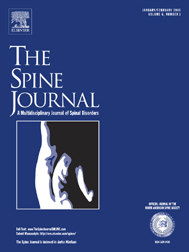
SPINE
Vertebral end-plate signal changes may not be the cause of disabling back pain in sciatica
This report has been verified
by one or more authors of the
original publication.
Spine J. 2014 Feb 1;14(2):225-33. doi: 10.1016/j.spinee.2013.08.058. Epub 2013 Nov 13.
Two hundred and sixty-three patients with sciatica were randomized to undergo either rapid surgical intervention, or prolonged conservative treatment. The dual purpose of this publication was (1) to compare the extent of vertebral end-plate signal changes (VESC) between groups, and (2) to determine whether or not there is a correlation between VESC and disabling back pain. Results at 1 year indicated that surgical treatment was significantly associated with an increase in the extent of VESC in patients with sciatica compared to conservative treatment. Furthermore, the proportion of patients reporting both disabling back pain (both at baseline and at 1 year) and perceived recovery was similar regardless if VESC was present or not.
Unlock the full ACE Report
You have access to {0} free articles per month.Click below to unlock and view this {1}
Unlock NowCritical appraisals of the latest, high-impact randomized controlled trials and systematic reviews in orthopaedics
Access to OrthoEvidence podcast content, including collaborations with the Journal of Bone and Joint Surgery, interviews with internationally recognized surgeons, and roundtable discussions on orthopaedic news and topics
Subscription to The Pulse, a twice-weekly evidence-based newsletter designed to help you make better clinical decisions
Exclusive access to original content articles, including in-house systematic reviews, and articles on health research methods and hot orthopaedic topics
Or upgrade today and gain access to all OrthoEvidence content for just $1.99 per week.
Already have an account? Log in


Subscribe to "The Pulse"
Evidence-Based Orthopaedics direct to your inbox.
{0} of {1} free articles
Become an OrthoEvidence Premium Member. Expand your perspective with high-quality evidence.
Upgrade Now













































































